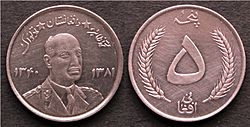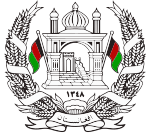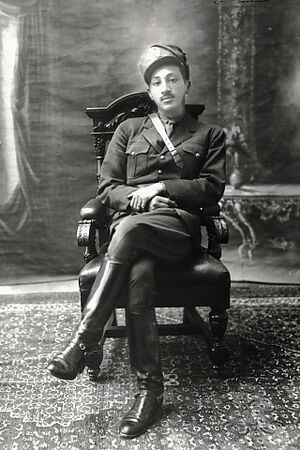Mohammad Zahir Shah facts for kids
Quick facts for kids Mohammad Zahir Shahمحمد ظاهر شاه |
|
|---|---|

King Zahir Shah in 1963
|
|
| King of Afghanistan | |
| Reign | 8 November 1933 – 17 July 1973 |
| Installation | 8 November 1933 |
| Predecessor | Mohammad Nadir Shah |
| Successor | Monarchy abolished (Daoud Khan as President of Afghanistan) |
| Head of House of Barakzai | |
| Tenure | 17 July 1973 – 23 July 2007 |
| Predecessor | Himself As King of Afghanistan |
| Successor | Ahmad Shah Khan |
| Born | 15 October 1914 Kabul, Afghanistan |
| Died | 23 July 2007 (aged 92) Kabul, Afghanistan |
| Burial | Maranjan Hill |
| Spouse | Humaira Begum |
| Issue | Princess Bilqis Begum Prince Muhammed Akbar Khan Crown Prince Ahmad Shah Khan Princess Maryam Begum Prince Muhammed Nadir Khan Prince Shah Mahmoud Khan Prince Muhammed Daoud Pashtunyar Khan Prince Mir Wais Khan |
| House | Barakzai |
| Father | Mohammad Nadir Shah |
| Mother | Mah Parwar Begum |
| Religion | Sunni Islam |
| Signature |  |
Mohammad Zahir Shah (Pashto/Dari: محمد ظاهر شاه, 15 October 1914 – 23 July 2007) was the last king of Afghanistan. He ruled for 40 years, from 1933 to 1973. This made him the longest-serving ruler of Afghanistan in centuries.
During his time as king, Zahir Shah helped Afghanistan connect with many countries. He also started to modernize the country in the 1950s. This led to a new constitution and a system where the king shared power. His long rule was known for peace in Afghanistan.
In 1973, while Zahir Shah was getting medical treatment in Italy, his cousin Mohammad Daoud Khan took over the country. Daoud Khan created a republic, ending the monarchy. Zahir Shah lived in Italy until 2002. He returned to Afghanistan after the Taliban government fell. He was given the special title Father of the Nation and held it until he passed away in 2007.
Contents
Zahir Shah's Early Life and Family
Zahir Shah was born on 15 October 1914, in Kabul, Afghanistan. His father was Mohammad Nadir Shah, a high-ranking member of the royal family. His mother was Mah Parwar Begum.
Nadir Shah became king in 1929. Zahir Shah's family had been exiled to British India before he was born. They returned to Afghanistan later.
Zahir Shah went to special schools for princes in Afghanistan. He also studied in France, where his father had worked as a diplomat. He learned at the Pasteur Institute and the University of Montpellier. When he came back to Afghanistan, he helped his father bring order to the country. He also worked as a deputy war minister and minister of education.
Becoming King and Modernizing Afghanistan
Zahir Shah became king on 8 November 1933, when he was 19 years old. After his father was assassinated, he was given the title "He who puts his trust in God, follower of the firm religion of Islam."
For nearly 30 years, his uncles, Mohammad Hashim Khan and Shah Mahmud Khan, served as prime ministers. During this time, Afghanistan joined the League of Nations in 1934. It also made trade agreements with many countries.
Afghanistan's Neutrality in World Wars
Even though Afghanistan had ties with countries like Germany, Italy, and Japan, Zahir Shah and his government stayed neutral during World War II. Afghanistan was one of the few countries that did not take sides.
After the war, Zahir Shah saw that Afghanistan needed to modernize. He brought in foreign experts to help. The country's first modern university was also started during his rule. He asked for financial help from both the United States and the Soviet Union. Afghanistan was one of the few countries to get aid from both sides of the Cold War.
Zahir Shah was seen as a kind leader. He never ordered anyone to be executed for political reasons. He also sometimes changed death sentences for criminals. In 1964, a new constitution was introduced. This made Afghanistan a modern democratic state. It brought in free elections, a parliament, and women's rights.
Many coins from his reign had the Arabic title "AlMutawakkil 'ala Allah Muhammad Zhahir Shah." This means "The leaner on God, Muhammad Zhahir Shah."
When he returned to Afghanistan in 2002, people remembered his rule as a time of peace.
Life in Exile: The King Away from Home
In 1973, while Zahir Shah was in Italy, his cousin Mohammad Daoud Khan took control of the country. Daoud Khan had been prime minister before. He believed Zahir Shah was not leading strongly enough.
In August 1973, Zahir Shah sent a letter from Rome. He said he accepted the will of his people and that they wanted a republic. He lived in Italy for 29 years with his wife, Queen Humaira Begum. They lived in a villa in Rome.
The Shah of Iran helped support him financially. The new Afghan government stopped sending money after a revolution. During the Soviet war in Afghanistan, Zahir Shah thought about leading a government from exile. However, he could not agree with all the different groups.
In 1991, someone tried to attack Zahir Shah with a knife. Many people wanted him to return to Afghanistan and bring back the monarchy. They thought he could unite the country.
Returning Home: Father of the Nation
On 18 April 2002, Zahir Shah returned to Afghanistan at 87 years old. He came back after the Taliban rule ended. Hamid Karzai and other officials welcomed him at the airport. Many Afghans were happy to see him.
There were ideas to bring back the monarchy. Zahir Shah said he would accept any role the Loya Jirga (a grand assembly) gave him. But he also said he did not want to be king again. He preferred the title "Baba" (Father).
Hamid Karzai became president of Afghanistan. He called Zahir Shah a "symbol of unity" and a "fatherly figure." After the Loya Jirga, Zahir Shah was given the title "Father of the Nation." This title showed his important role in uniting Afghanistan. He moved back into his old palace in Kabul in August 2002.
In his final years, Zahir Shah was frail. He needed a microphone so people could hear his soft voice. In January 2007, he became very ill.
His Final Years and Passing
Zahir Shah passed away on 23 July 2007, at the presidential palace in Kabul. He had been sick for a long time. President Karzai announced his death on national television. He said Zahir Shah was a "servant of his people" and a "very kind person."
His funeral was held on 24 July. It started at the presidential palace. His coffin was then taken to a mosque. Finally, he was buried in the royal mausoleum on Maranjan Hill in eastern Kabul.
| 5 Afghan afghani (1961) | |
|---|---|
 |
|
| Front: Picture of Mohammad Zahir Shah. | Back: Wheat ears and the number 5. |
| An Afghani coin from King Zahir Shah's time, made around 1962. | |
About Zahir Shah: His Hobbies and Languages
Zahir Shah was known for being shy and modest. He enjoyed photography, playing chess, and smoking cigars.
He spoke Pashto and Dari fluently. He could also speak English and perfect French. His family called him Baba.
His Family: Children and Grandchildren
He married his cousin Humaira Begum in 1931. They had six sons and two daughters:
| Name | Birth | Death | Marriage | Their children | |
|---|---|---|---|---|---|
| Date | Spouse | ||||
| Princess Bilqis Begum | 17 April 1932 | 1951 | Abdul Wali Khan | Princess Humaira Begum | |
| Princess Wana Begum | |||||
| Princess Mayana Khanum | |||||
| Crown Prince Muhammed Akbar Khan | 4 August 1933 | 26 November 1942 (aged 9) | |||
| Crown Prince Ahmad Shah Khan | 23 September 1934 | 1961 | Khatul Begum | Prince Muhammad Zahir Khan | |
| Prince Muhammad Emel Khan | |||||
| Princess Hawa Khanum | |||||
| Princess Maryam Begum | 2 November 1936 | 25 December 2021 (aged 85) | 1960 | Sardar Muhammad Aziz Khan Naim | Sardar Nadir Khan Naim |
| Prince Muhammed Nadir Khan | 21 May 1941 | 3 April 2022 (aged 80) | 6 February 1964 | Lailuma Begum | Prince Mustapha Zahir Khan |
| Prince Muhammad Daud Jan | |||||
| Prince Shah Mahmoud Khan | 15 November 1946 | 7 December 2002 (aged 56) | 18 April 1966 | Safura Begum | Princess Bilqis Khanum |
| Princess Ariane Khanum | |||||
| Prince Muhammed Daoud Pashtunyar Khan | 14 April 1949 | 2 February 1973 | Fatima Begum | Prince Duran Daud Khan | |
| Princess Viona Khanum | |||||
| Princess Noal Khanum | |||||
| Prince Mir Wais Khan | 7 January 1957 | 30 May 2009 | Princess Safya Zaher | ||
One of his grandsons, Mustafa Zahir, was considered a possible candidate for president in 2009. His granddaughter, Princess Noal of Afghanistan, is married to Muhammad Ali, Prince of the Sa'id.
Titles and styles
| Styles of Mohammad Zahir Shah of Afghanistan |
|
|---|---|
 |
|
| Reference style | His Majesty |
| Spoken style | Your Majesty |
During his reign, he was known as His Majesty Mohammad Zahir Shah, King of Afghanistan.
See also
 In Spanish: Mohammed Zahir Shah para niños
In Spanish: Mohammed Zahir Shah para niños





